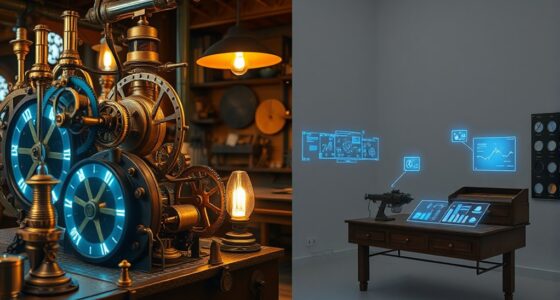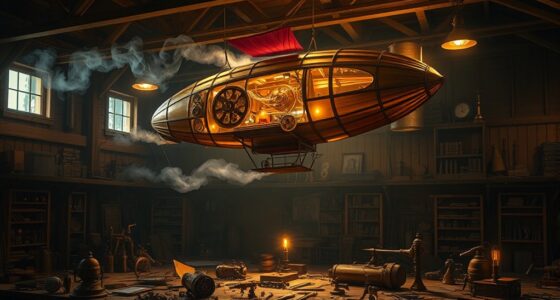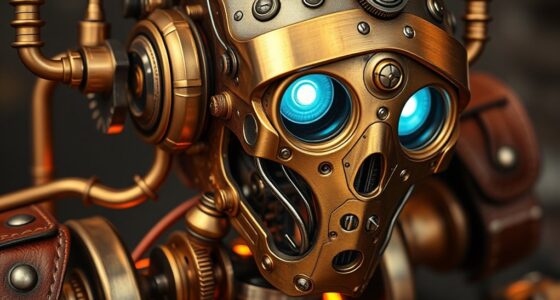Steampunk blends real historical innovations with imaginative inventions, letting you explore a whimsical world of retrofuturistic technology. You'll see steam power driving devices and machines fashioned from materials like brass and copper, inspired by literary giants like Verne and Wells. The unique aesthetic also draws from Victorian design while questioning our understanding of the past. Keep an eye on those fascinating creations, as you'll uncover even more about the genre's captivating evolution soon.
Key Takeaways
- Steampunk inventions combine real Victorian technology, like steam power and clockwork mechanisms, with imaginative and fantastical elements for a unique aesthetic.
- Many steampunk devices, such as airships and rayguns, draw inspiration from historical advancements while infusing whimsical creativity.
- The genre often explores the emotional complexity of machines, merging real engineering principles with fictional narratives in automatons and other gadgets.
- Modern technologies, like 3D printing and virtual reality, allow creators to bring both real and imaginary steampunk inventions to life.
- Steampunk emphasizes DIY culture, encouraging inventors to blend historical techniques with innovative designs, fostering a sense of community among makers.
Definition and Origins of Steampunk
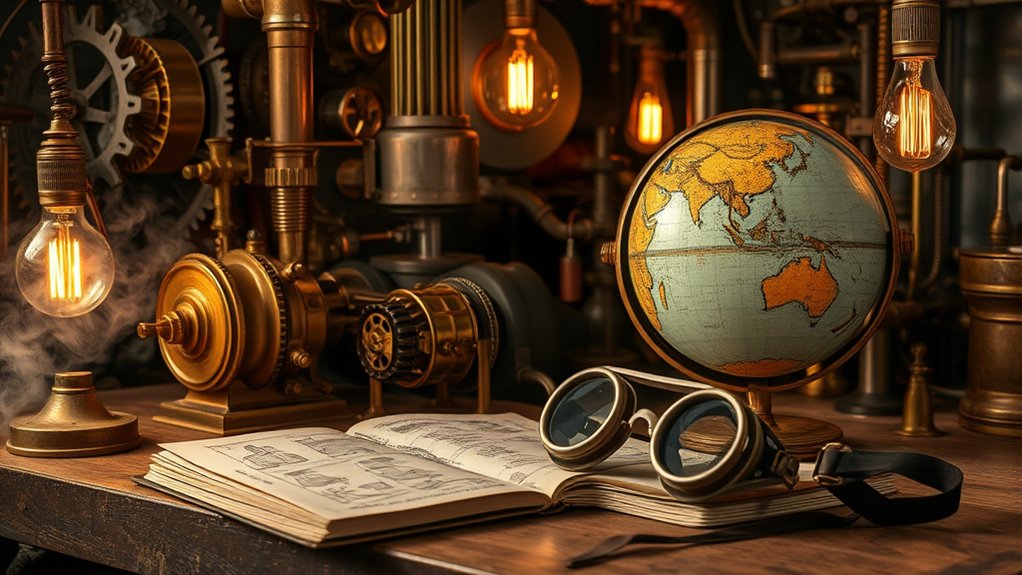
Steampunk, as a captivating subgenre of science fiction, merges historical and futuristic elements, often set against a Victorian-era backdrop. It combines retrofuturistic technologies, powered by steam, with a flair for the whimsical. You'll find inspirations from literary giants like Jules Verne and H.G. Wells, whose works paved the way for this imaginative genre. The term "steampunk" was coined by K.W. Jeter in 1987, humorously contrasting with cyberpunk. This genre's charm lies in its exploration of alternative histories, posing "what if" scenarios that challenge your understanding of the past. Steampunk reflects the societal shifts of the Industrial Revolution while offering a playful twist on technology, inviting you to envision a world where history meets innovation. Additionally, various art forms such as literature, film, and video games are integral to the steampunk movement, showcasing its broad cultural impact.
Key Characteristics of Steampunk Inventions
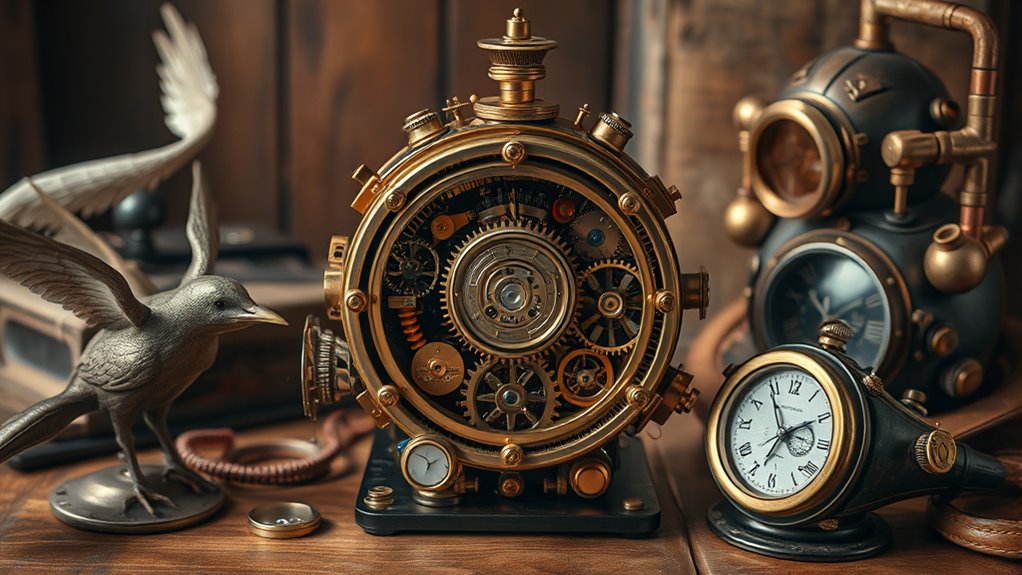
In the world of steampunk, inventions stand out for their unique blend of historical charm and imaginative technology.
You'll notice that these creations often reimagine modern gadgets with a Victorian flair, using materials like brass, copper, and leather. Steam power is a vital element, driving various devices and machines. The Steampunk movement gained momentum in the summer of 2006 with innovative designs that captivated a growing community of enthusiasts.
Anachronistic designs combine futuristic concepts with past technologies, resulting in fascinating gadgets. You'll find innovative materials like polished wood and intricately engraved metal parts, showcasing elaborate craftsmanship.
The retro-futuristic aesthetic evokes nostalgia while allowing for fantastical applications, such as steam-powered mechanical beasts and airships.
Ultimately, steampunk inventions challenge societal norms, sparking your imagination and inviting you into a world where history meets speculation.
Real-Life Inspirations for Steampunk Technology
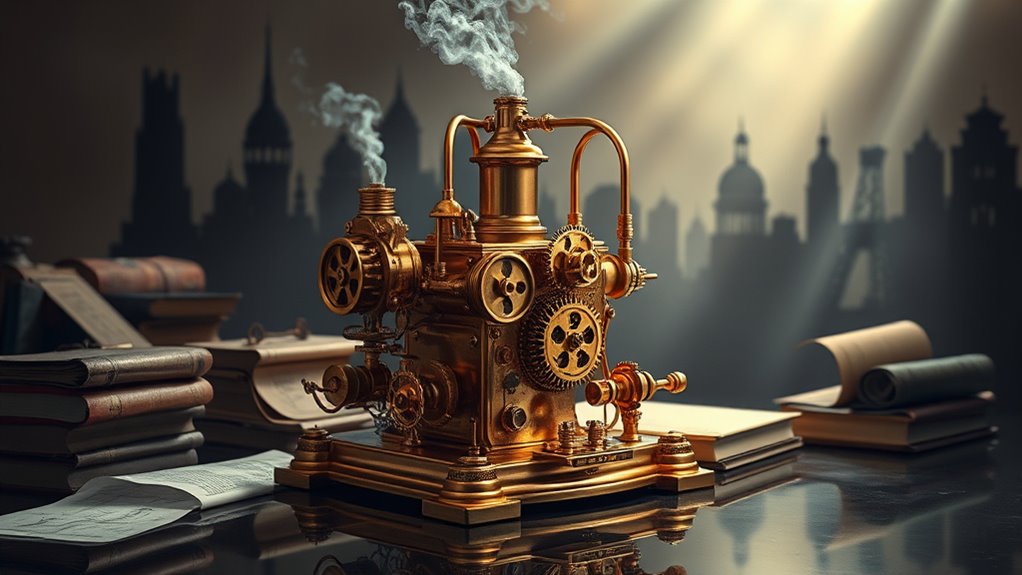
While exploring the fascinating world of steampunk technology, you'll find that real-life inspirations abound in the rich history of the Victorian era.
Steam power transformed transportation and manufacturing, laying the groundwork for the fantastical gadgets you adore. Innovations like clockwork mechanisms and early computers, pioneered by figures like Charles Babbage, bring a mechanical aesthetic to life. The intricate designs of automata and medical devices, such as carbolic acid sprayers, highlight Victorian ingenuity. Additionally, the use of brass and copper in these inventions enhances steampunk's visual appeal. The concept of aether as a power source also reflects the era's fascination with unseen forces and energy. Furthermore, the use of renewable energy sources in modern homesteading practices echoes the innovative spirit of the Victorian era, showcasing how past and present intertwine in the realm of technology. In particular, the advancements in color accuracy during the Victorian era set the stage for future developments in visual technologies.
Imaginary Devices and Their Cultural Significance

Imaginary devices in steampunk not only captivate the imagination but also serve as reflections of cultural values and aspirations. Airships, often designed as elegant zeppelins, symbolize human ingenuity and adventure, showcasing advanced navigational tools and ornate brass details. Steampunk gadgets are functional items with aesthetic appeal and further enhance the allure of this genre, merging utility with artistry. Rayguns, quintessential steampunk weapons, blend retrofuturistic technology with Victorian aesthetics, representing power and sophistication. Automatons blur the line between machine and sentient being, inspiring narratives that explore emotional complexity. Steampunk fashion, with its fusion of Victorian styles and modern elements, encourages DIY craftsmanship and reflects a lifestyle that embraces both heritage and futurism. Through storytelling, steampunk explores alternate histories, critiques industrialization, and delves into themes of identity and technology, creating a rich tapestry that connects past and future sensibilities.
The Role of Steam Power in Steampunk Design
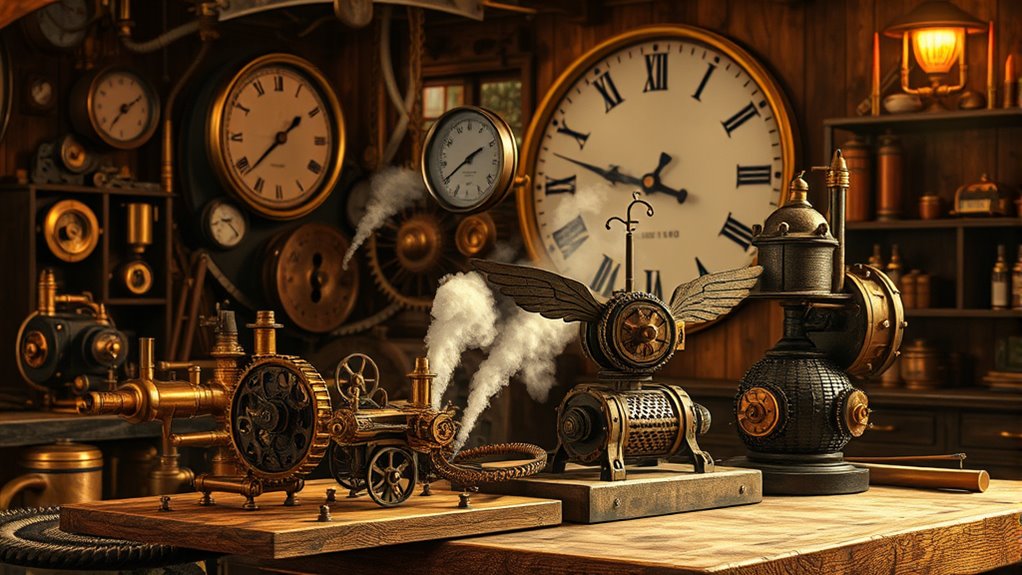
Steam power serves as the heartbeat of steampunk design, infusing creativity with a sense of historical authenticity. By harnessing steam's mechanical energy, you can evoke a retro-futuristic aesthetic, blending the past with imaginative innovation. The basic operation of steam engines—boiling water to push pistons or turn turbines—highlights the versatility of this technology, inspiring diverse devices from simple machinery to complex automatons. In your designs, visible gears, steam valves, and other elements can enhance the aesthetic appeal while serving narrative themes about alternate historical paths. Steampunk also encourages you to explore societal issues, reflecting on the impacts of industrialization and technological progress, all centered around the enduring allure of steam power. This genre's foundation in Victorian aesthetics allows for a rich tapestry of creativity that challenges perceptions of technology and history.
Innovations in Steampunk Art and Fashion
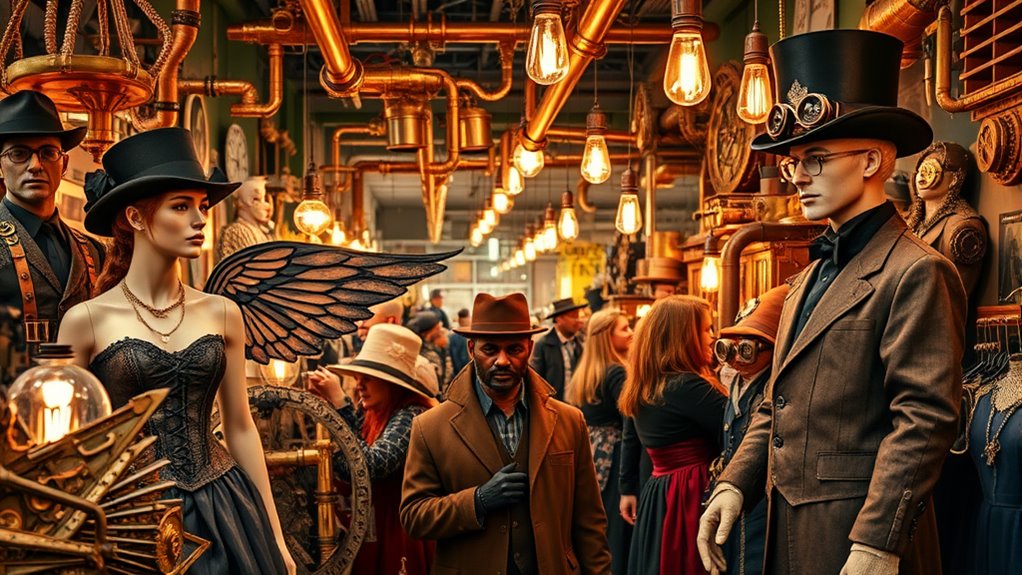
Steampunk art and fashion have taken the foundational elements of steam power and transformed them into vibrant expressions of creativity and style.
You'll notice how contemporary techniques and materials mix with Victorian aesthetics, making each piece uniquely captivating. Upcycled materials emphasize sustainability, while mainstream brands like Prada and Chanel weave steampunk elements into their collections. The incorporation of industrial and nostalgic themes is a hallmark of steampunk fashion, enhancing the overall aesthetic appeal.
Expect to see corsets, waistcoats, and goggles, often reflecting a post-apocalyptic vibe. Influences from goth, punk, and cyberpunk add dark romanticism and tech-inspired details.
The DIY ethos encourages you to experiment, creating one-of-a-kind outfits. With advances in fabric technology and 3D printing, the possibilities for innovation in steampunk fashion are endless, blending traditional charm with modern flair.
Steampunk in Literature and Film
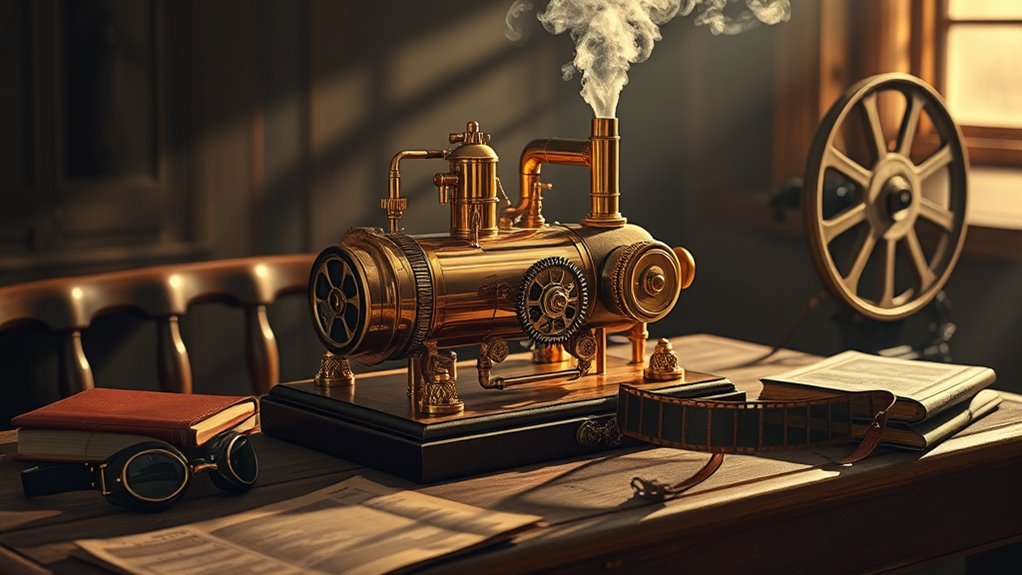
While exploring the realms of literature and film, you'll often encounter narratives steeped in the unique blend of Victorian aesthetics and imaginative technology that defines the steampunk genre. Notable works like "Perdido Street Station" by China Miéville and "The Difference Engine" by William Gibson and Bruce Sterling showcase retrofuturistic settings where steam power reigns. These stories often incorporate elements of fantasy, horror, and alternate history, making them rich with hybrid themes. Additionally, the genre merges Victorian elegance with industrial machinery, creating a captivating world for readers and viewers alike. In film, works such as "Hugo" and "Steamboy" visually captivate with intricate mechanical devices and Victorian-inspired designs. You'll also find influences in anime and manga, particularly in Hayao Miyazaki's creations.
The Future of Steampunk: Trends and Evolution

As the steampunk genre continues to evolve, it embraces a vibrant blend of cultural influences and modern technologies that reflect our changing world. You'll notice that steampunk is becoming increasingly diverse, welcoming enthusiasts from various backgrounds. This global subculture inspires innovative fashion, merging Victorian aesthetics with sustainable practices and smart textiles. Technological advancements like virtual reality and 3D printing enhance the immersive experience while maintaining the genre's retro charm. You might find DIY ethics thriving, aligning with the gig economy and encouraging creativity. Steampunk also addresses environmental themes, prompting reflection on past decisions and proposing retro-futuristic solutions. As it connects with the Maker Movement, steampunk invites you to explore new horizons in creativity and expression.
Frequently Asked Questions
How Can I Create My Own Steampunk Inventions?
To create your own steampunk inventions, start by researching technological advancements from the Victorian era.
Study historical inventors and their designs for inspiration, then mix those ideas with your imagination. Incorporate elements like clockwork mechanisms or fictional materials to add uniqueness.
Make sure your inventions serve a purpose within a narrative, connecting them to characters and their challenges.
Finally, balance practicality with fantasy to keep your creations engaging and believable.
What Materials Are Best for Steampunk Projects?
What materials can you use to bring your steampunk creations to life?
Start with wooden dowels for structure and flexible metal faucet connectors for durability. Incorporate copper and brass tubes for that authentic look, and don't forget about PVC pipes for versatility.
Old furniture and broken jewelry can be repurposed into unique accessories.
Finally, add gears and vintage fabrics to enhance the industrial aesthetic, making your project truly stand out.
Are There Steampunk Conventions or Events to Attend?
Yes, there are plenty of steampunk conventions and events you can attend!
From the Wild Wild West Steampunk Convention in Tucson to the Watch City Steampunk Festival in Massachusetts, the options are diverse.
These events feature costume contests, workshops, and live performances, providing great opportunities to connect with fellow enthusiasts.
Mark your calendar for these gatherings; they're perfect for immersing yourself in the steampunk community and sharing your passion for the genre!
How Do I Incorporate Steampunk Into My Home Decor?
To create a steampunk atmosphere in your home, start by blending industrial elements with Victorian charm.
Use neutral backgrounds to highlight metallic textures and leather accents. Incorporate vintage maps and whimsical items like clocks and compasses for authenticity.
Choose antique or refurbished furniture and enhance it with metal accents.
Don't forget to mix fabrics like cotton and linen with gradients of black, gray, and copper to complete the look.
Embrace creativity and let your imagination guide you!
What Resources Are Available for Learning Steampunk Crafting Techniques?
To learn steampunk crafting techniques, you've got plenty of resources at your fingertips.
Check out YouTube for video tutorials that walk you through various projects step-by-step. Pinterest is great for inspiration and project ideas.
You can also explore blogs like Jen's on Epbot for detailed instructions.
Don't forget to dive into historical books and websites about 19th-century inventions for a deeper understanding of the aesthetic and mechanics behind your creations.
Conclusion
In the world of steampunk, imagination fuels innovation, reminding us that "necessity is the mother of invention." By blending real and fantastical elements, you get a unique lens through which to explore technology and creativity. As steampunk continues to evolve, it inspires you to reimagine the past while shaping the future. So, embrace the whimsy and wonder of steampunk—after all, the limits of your creativity are only bound by your imagination!


